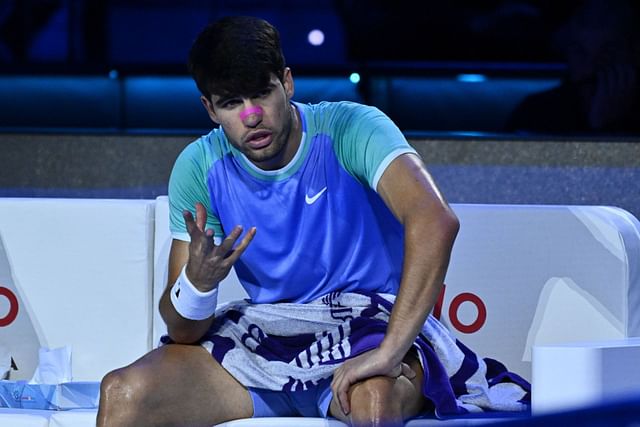Carlos Alcaraz, the 2022 US Open champion and one of the brightest young talents in tennis, has become a fan favorite for his explosive game, infectious energy, and humble demeanor. However, in the run-up to his much-anticipated debut at the 2025 ABN AMRO World Tennis Tournament in Rotterdam, the Spaniard has been dealing with a different kind of challenge—his health. Recently, Alcaraz was spotted wearing a nasal strip, a move that stirred conversation among tennis enthusiasts and added a layer of intrigue to his return to competitive play.
Nasal strips, though commonly used by athletes in various sports to improve airflow and reduce nasal congestion, aren’t a frequent sight in tennis. However, this simple yet effective tool seems to have made a comeback in Alcaraz’s kit as he prepares for his first match in Rotterdam. The appearance of the nasal strip has sparked discussions on whether Alcaraz is dealing with illness, an injury, or simply using it for performance-enhancing purposes. Whatever the case may be, the sight of the strip has drawn attention to the 20-year-old’s health and his readiness to compete at the top level.
### The Nasal Strip: A Familiar Sight
For many tennis fans, Carlos Alcaraz wearing a nasal strip is a reminder of the time when he used it during his breakthrough season in 2022. Back then, Alcaraz sported a nasal strip on occasion, with many speculating it was a tactic to help with breathing during intense matches, especially in high-altitude tournaments like those played in Spain or certain parts of the U.S.
The nasal strip works by physically widening the nostrils and improving airflow through the nasal passages, which can be particularly beneficial when the athlete is struggling with nasal congestion or experiencing respiratory challenges during exertion. For athletes like Alcaraz, who rely on stamina, lung capacity, and consistent breathing during long rallies, such a tool can offer a minor but significant advantage.
Though it may seem like a small detail, the return of the nasal strip brings with it a new layer of concern for Alcaraz’s fans, especially with his appearance at Rotterdam coming into focus. So, what is the significance of his recent use of a nasal strip, and why does it raise questions about his health?
### A Sickly Alcaraz: Health Concerns Before Rotterdam
In the days leading up to the Rotterdam tournament, Alcaraz was seen appearing under the weather, showing signs that something wasn’t quite right with his physical condition. This wasn’t just a case of a slight cold or temporary fatigue; Alcaraz looked uncharacteristically sluggish and pale during his practice sessions. Rumors started to circulate that the young star had been battling an illness in the days prior to his arrival in the Netherlands. Some speculated that it might be the flu, while others believed it could be a more seasonal cold, common among athletes traveling across various climates during the winter months.
Alcaraz himself remained tight-lipped about the specifics of his health. However, his decision to wear the nasal strip during practice sessions raised even more questions. Could the nasal strip be a sign that he was dealing with nasal congestion or a respiratory issue that was affecting his ability to breathe comfortably? If so, it would make sense that he would seek an added advantage in terms of airflow, especially in preparation for his debut in Rotterdam.
While athletes are often expected to push through illness or injury, the timing of Alcaraz’s struggles is particularly notable as it comes just before the start of an important European indoor hardcourt season. Rotterdam is one of the biggest ATP 500 events of the year, and for Alcaraz, who is currently ranked number two in the world, it’s a vital opportunity to gain valuable ranking points and build momentum ahead of the upcoming Masters 1000 events and the clay season.
### The Pressure to Perform and the Toll on His Body
At just 20 years old, Carlos Alcaraz has already achieved what many players only dream of—becoming a Grand Slam champion and establishing himself as a top contender in every tournament he enters. However, the rapid rise to the top also comes with its own set of challenges. The pressure to perform at such a high level, particularly after a breakthrough year like 2022, can be physically and mentally exhausting.
Alcaraz’s playing style is one of relentless aggression, with a focus on fast court coverage, explosive groundstrokes, and fearless net play. While these qualities have made him one of the most exciting players to watch, they also take a significant toll on his body. Tennis is a physically demanding sport, and young players like Alcaraz often face the challenge of balancing their physical health with the demands of a grueling schedule.
This year, Alcaraz has already participated in multiple tournaments, including the 2025 Australian Open, where he made a deep run. However, such extensive traveling, coupled with the intense physical exertion of match after match, can leave players vulnerable to illness. Traveling through different time zones, adjusting to new climates, and playing in various indoor and outdoor conditions can all impact an athlete’s immune system, leaving them more susceptible to colds, flu, or respiratory infections.
This combination of factors—Alcaraz’s exhausting schedule, his playing style, and the stress of defending his ranking—may have contributed to his current condition, prompting the use of the nasal strip as a tool to manage his breathing while he recovers.
### Rotterdam: A Key Moment for Alcaraz
The ABN AMRO World Tennis Tournament in Rotterdam holds significant importance for Alcaraz as he prepares for the rest of the season. With the 2025 French Open looming large in the distance, Alcaraz needs to maintain his fitness and form to compete against the likes of Novak Djokovic, Daniil Medvedev, and Stefanos Tsitsipas. The indoor hardcourt season, especially events like Rotterdam, offers players a unique opportunity to hone their game in a controlled environment before the grueling clay and grass court seasons kick off.
Alcaraz’s decision to debut at Rotterdam, despite feeling under the weather, speaks to his determination to remain competitive and stay ahead in the ATP rankings. However, it’s also a reminder that even the best players in the world face physical setbacks and health challenges. While the nasal strip may appear to be a minor detail, it highlights Alcaraz’s commitment to his craft, as well as his strategic mindset to ensure he can perform even when not at his absolute best.
### Conclusion: A Balanced Approach to Health and Performance
Carlos Alcaraz’s use of the nasal strip as he battles an illness ahead of his Rotterdam debut adds a layer of complexity to his already impressive journey. It shows the human side of the tennis star—no longer just a young prodigy chasing records, but a professional athlete managing the daily realities of competing at the highest level. As he pushes through health concerns and prepares for his next match, Alcaraz’s resilience and focus will be tested once again.
While it’s unclear whether his illness will impact his performance in Rotterdam, one thing is for certain: Alcaraz’s determination to succeed is unwavering. For fans, the sight of the nasal strip will serve as a reminder that even champions face obstacles, but with the right mindset and tools at their disposal, they can overcome them and continue to shine on the big stage.






Leave a Reply